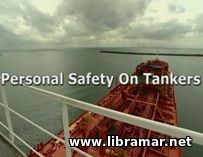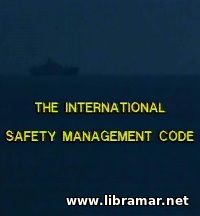 This video training is dealing with the personal safety on board tanker ships. It also belongs to the Personal Safety On Board Ships training series. It is discussing the hazards commonly expected on the tankers. First of all, it is looking at the confines spaces that shall only be entered once they have been thoroughly checked and ventilated. The good housekeeping, due and timely maintenance of all shipboard mechanical equipment and periodically performed inspections for leaks have also been covered.
The video is also dealing with the applicable safety regulations that shall always be complied with, particularly in respect of using mobile phones, smoking, photographing etc. Note that the other parts of the series dealing with the safety in accommodation, in the galley, in the engine room, on deck and on board such types of ships as chemical tankers, bulk carriers, container vessels and general cargo vessels are also available and supplemented with the associated training booklet. It is recommended to all people working or planning to work at sea to go through the content of the booklet and each of the videos making this training program to get full understanding of the personal safety.
 This is a training video supplementing the booklet of the second part of the training series dealing with the entry into enclosed spaces. While the opening part of the course dealt with the Awareness (booklet & video), this particular one addresses the preparation and procedures. The content of the video presents an excellent attempt of Videotel specialists to demonstrate the techniques for proper recognition of the enclosed spaces and associated hazards.
The target audience for the whole training course remains same - it is made of the deck officers and ratings who are working on board vessels, people working in the engine room and in fact all other people since the safety matters are considered equally important to any person on board any ship.
Try and go through every single part of the course including video films and booklets and you will get your knowledge of the safety in the enclosed spaces significantly improved which will eventually contribute in your own safety as well as to the safety of your teammates. The content is easily understandable and does not require any specific technical background so the course and be recommended even to the absolute newcomers to the shipping and offshore industry, who fill find so much of practical and useful information.
 The present training video shall be supplementing the booklet covering the Equipment used for the safe entry into enclosed spaces on board ships and offshore structures. It is the part three of the world famous training series commenced with the Awareness and Preparation and Procedures related sections.
The video is addressing all important aspects of using correct equipment when working in the confined spaces taking into consideration the hazards that may be expected in those areas and degree of protection provided by each of the equipment such as PPE, i.e. personal protective equipment, EEBD, i.e. emergency escape breathing device, and all others that are commonly used on board.
The video demonstrates the correct use of the equipment as this is very important aspect of personal safety. We highly recommend all our uses to check not only this part of the training series but also all of the previously released parts including both information booklets and associated training video films to get full picture of the safety procedures and arrangements on board any vessel. This is considered a very good and useful supplement to the standard mandatory safety training provided on board.
 One has to be very careful in the enclosed spaces since we know that such spaces can kill. A recent studies suggest that over the last fifteen years or so maybe up to a thousand seafarers have died in enclosed spaces. We know that what really determines the safety of people working in the enclosed spaces is not what goes on when they are in them but what should have been taken care of well before.
So you have got to be very careful and there are so many things to think about, a lot to consider and you want to live you simply cannot afford to let it go wrong... The present training video supplements the booklet addressing the enclosed spaces entry. They both make the part four of the training series developed to provide seafarers with the necessary information about such spaces and techniques/procedures to be used when entering them.
The previous three parts of the series are dealing with the Awareness, Preparation and Procedures, and Equipment; note that they are all available at Libramar. We recommend all our visitors to have a close look in each booklet and video to get fully prepared to entering and working in the enclosed spaces safely as this is the first thing they all should do - care about their own safety.
 This is a training video supplementing the booklet for the part five of the Entry Into Enclosed Spaces series and this part is dealing with the emergency procedures and rescue. Of all the hazards faced by seafarers, enclosed spaces are maybe the most deadly because in most cases entry procedures are not been properly followed and the consequences are normally fatal.
Of the majority of people who died is not those who first entered the space and then get into the difficulty; it is those who attend to rescue them. They die because they are not trained; because instinct takes over and becomes more powerful that the knowledge gained from training. They die because instinct kills. An emergency rescue has to be carried out by people who know exactly what they are doing, and success is easily measured - the people they are taking out of the enclosed space are either alive or not.
What often makes the difference is the degree of planning and preparation that should take place days, weeks and months before. Recognition that the provision of the safety in the enclosed spaces requires proper management plan... The video supplements this training booklet. And the other four parts of the series cover Awareness, Preparation and Procedures, and Equipment, and Enclosed Space Entry itself.
 The last part of the training series, and this one is devoted to the correct use of the BA, standing for the breathing apparatus, in the course of the emergency and rescue operations. In our job, we get plenty of fresh air and the air contains oxygen meaning to stay alive, but just how much air do we need? It depends on the body's energy requirements. During rest, we may only use sixteen to twenty liters a minute.
But, if you are wearing breathing apparatus, in an emergency this can rise to forty liters of fresh air peach minute due to the raised stress level of the wearer. If extra-heavy work is performed at the same time, fifty to sixty liters of air may be consumed. But why? When physical effort is required, the body needs more oxygen. Fresh air contains twenty-one per cent oxygen; this will never change.
So, the only way of getting more oxygen is to increase breathing rate... Check the accompanying training booklet on the correct use of BA and, of course, feel free to download and go through the content of all previously released training videos belonging to the Entry Into Enclosed Spaces series and covering the Awareness, Preparation and Procedures, Equipment, Enclosed Space Entry itself and Emergency Procedures and Rescue.
 During the analysis performed by the Standard Cub of his own claims exceeding two hundred thousand dollars it was found that many of the claims were caused by human error and were actually avoidable. The International Maritime Organization has been looking at a problem of safety management and pollution prevention for some time now.
Following the principles mapped out in ISO 9002, they have developed the Safety Management Code which sets out procedures and requirements for shipboard management. During the conference held in 1994 the Code became part of the SOLAS convention and has been since then applied to all shipping lines enforced by various ports and Flag states.
The Standard Club already requires its members to subscribe to some fairly basic operating procedures as a condition of membership, and believes that owners who do not comply with the ISM Code by the due date will find it difficult to obtain it. The Safety Management Code has the thirteen point philosophy, each point dealing with the specific component of safety management.
The ten main points refer to disclosure, company policy, commitment, decision making, written instructions, level of authority, logistical support, emergency procedures, compliance, and verification. The Company will need to define and document the lines of communications, the responsibility and authority of each employee, and the links between those involved in the safety management system...
 This is the training video to supplement the booklet addressing fatigue. As we know, fatigue is treated as one of the contributors to the risk to the crew members and to the ship. This training program is mainly aimed at the senior officers who, upon completion of the course, will cascade the content down to the other crew members.
The authors of the course have covered all important aspects of fatigue and the measures to minimize it. They have provided numerous practical instructions that, when properly followed, will eventually result in significant reduction of the fatigue. The main emphasis has been placed by the developers of this training on the assessment of the risk associated with the fatigue, covering risk elements that are commonly considered specific to the different departments.
The general risk elements would normally include noise and vibration management, food and drink, working of the crew members in extreme temperatures, stresses, personal problems that crew members may have, watchkeeping, planning and others. All of them shall be paid due attention. Have a close look in the boo and video to get a full picture of what the fatigue is, what hazards and risks it may result in and what shall be done to minimize the fatigue...
|







